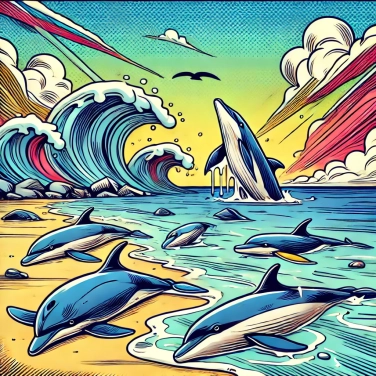Dolphins and whales can strand on beaches due to diseases, injuries, exceptional tides, magnetic disturbances, disorientation caused by human noise, or other factors.

Cetaceans, such as dolphins or whales, possess a very sophisticated echolocation system to navigate in the water, using sounds and their echoes to map their environment. But sometimes, this natural mechanism is no longer sufficient, especially during violent storms that obscure their acoustic landmarks or distort the profile of the shores and seabeds. Certain areas where the coastal relief is very flat and gently sloping also generate humidity and a somewhat deceptive sound reflection that misleads the animals' interpretation. It even happens that spontaneous variations in tide levels or rapid changes in currents trap individuals who realize too late that they are dangerously approaching the shore. These natural phenomena are perfectly normal, but unfortunately, they can completely confuse their senses and cause them to strand.
Dolphins and whales can sometimes fall victim to infections or diseases that may affect their perception or ability to navigate. For example, certain parasites or viruses target the inner ear, which is essential for managing balance and orientation. An infection at this level easily leads to navigation errors towards shallow waters, thereby increasing the risk of stranding. Other diseases, such as severe respiratory infections, can weaken their physical abilities, causing them to instinctively seek shallow waters to recharge, and this is often where the trap lies. Finally, some neurological diseases cause confusion and unusual behavior, disrupting their natural sense of movement at sea.
Human activities significantly disrupt the lives of whales and dolphins. For example, the intense noise from military sonars or underwater explosions can disorient them, sometimes causing panic and beaching. Even intense maritime traffic, with the constant din of engines and propellers, leads to acoustic stress that disorients these cetaceans. Adding to this is the chemical pollution of the water: the substances we release weaken their immune system, degrade their overall health, and increase their vulnerability. Finally, abandoned fishing nets or accidental catches (bycatch) frequently trap these animals, sometimes leading them to beach or die at sea before reaching the shore.
Some researchers believe that whales and dolphins use the Earth's magnetic field somewhat like a natural compass to navigate the oceans. When there are geomagnetic anomalies, meaning areas where the magnetic field becomes disturbed or varies abnormally, cetaceans sometimes lose their bearings. As a result, they stray and risk ending up stranded on the beach. These disturbances in the magnetic field can occur for several reasons, such as intense solar activity or local underwater geological features. Navigation, which is usually reliable for these marine animals, is then disrupted and can sometimes lead to unexpected strandings.
Dolphins and whales often live in very tight-knit groups, with a strong social cohesion based on cooperation. They generally follow an experienced leader during their movements. But here's the problem: when this leader is disoriented, sick, or injured, the whole group can blindly follow, sometimes even beaching themselves voluntarily. This extreme solidarity explains why we frequently observe mass strandings: when a group member is unwell, the others often refuse to abandon them, even if it means risking their own lives. This altruistic behavior, while touching, can unfortunately be fatal.
Some species of whales migrate thousands of kilometers each year, often following specific routes passed down from previous generations. Any disruption to these migratory paths (such as anthropogenic noise or marine pollution) significantly increases their risk of stranding.
Some mass strandings involve entire groups of cetaceans. This can be explained by their strong social structure: when a sick or disoriented individual strands, other members of the group may try to help and unfortunately end up stranding themselves as well.
Even though the rescue of stranded cetaceans is always carried out with good intentions, it requires genuine expertise. Moving an improperly positioned or unfit animal can cause further injury or create a new risk of rapid stranding.
Solar storms and geomagnetic anomalies can disorient whales and dolphins, disrupting their perception of the Earth's magnetic field, which they use to migrate over long distances.
Sure! Here is the translation: "Yes, in many parts of the world, an increase in strandings is observed at specific times: those corresponding to their seasonal migrations or to particular oceanographic phenomena that lead to a sudden change in natural conditions."
Yes, human activities such as military exercises, maritime traffic, or underwater explosions generate intense noise pollution that severely disrupts the sense of orientation of whales and dolphins, potentially leading to strandings.
Cetaceans often live in tightly-knit groups with a strong social dynamic. When the dominant or sick individual becomes stranded, the entire group may follow out of social loyalty and instinctive behaviors.
Sure! Here’s the translation: "No, not always. If the animal is quickly taken care of by specialized teams, it can sometimes be revived and survive. However, the chances of survival decrease rapidly if the stranding lasts for a long time."
Contact local authorities or organizations specializing in animal rescue immediately. Avoid directly handling the animals for your safety and theirs, but try to prevent them from drying out by covering them with a damp cloth if possible.

No one has answered this quiz yet, be the first!' :-)
Question 1/5